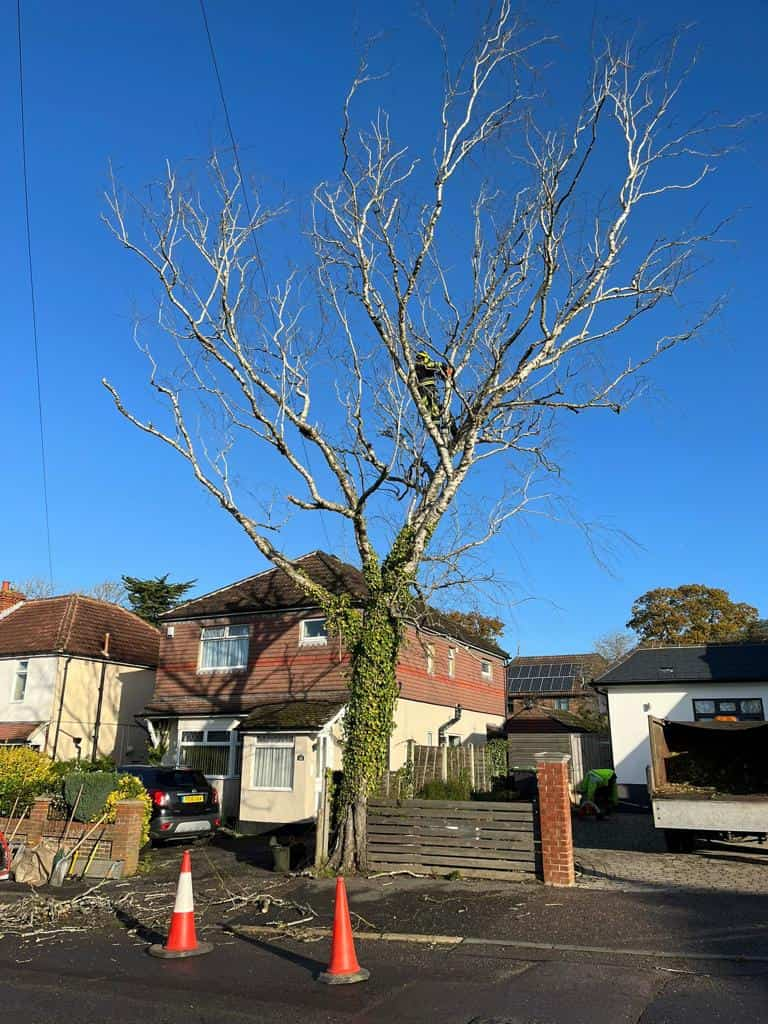Trees are a vital part of any landscape, providing beauty, shade, and environmental benefits. However, as trees grow, their crowns can become dense, leading to issues such as blocked sunlight, increased wind resistance, and potential safety hazards. Crown reduction is a professional tree surgery technique that effectively manages tree density, promoting health, safety, and aesthetics. At LM Tree Surgery Portchester, we offer expert crown reduction services to homeowners in Portchester, Hampshire, ensuring that trees remain balanced and well-maintained. Here’s how crown reduction is a practical solution for managing dense trees and enhancing your landscape.
1. Improving Sunlight Penetration and Air Circulation
A dense tree crown can create too much shade, limiting sunlight exposure to other plants and lawns below. Insufficient sunlight can inhibit growth and reduce the vibrancy of surrounding vegetation. Crown reduction involves selectively trimming the outer branches, thinning out dense sections to allow more light to reach the ground.
By improving sunlight penetration and air circulation, crown reduction supports the health of both the tree and its surroundings. Increased airflow through the crown also reduces moisture build-up, which helps prevent fungal growth and other diseases that thrive in humid environments. Healthier trees and plants contribute to a more attractive, well-balanced landscape.
2. Reducing Wind Resistance for Enhanced Safety
Large, dense trees are more susceptible to wind damage as their solid crowns create significant wind resistance. During storms or high winds, the increased force on the branches can lead to breakage or, in extreme cases, cause the tree to uproot. Crown reduction reduces the tree’s overall mass and wind resistance, allowing air to pass through the branches more easily.
For homeowners concerned about safety during adverse weather conditions, crown reduction provides a practical solution that reduces the risk of damage to property or injury to individuals. A tree with a well-reduced crown can stand up better to strong winds, making it a safer feature in residential areas.
3. Preserving Tree Health by Reducing Overextension
When tree branches grow excessively long or heavy, they can strain the overall structure of the tree, leading to breakage or damage. Overextended branches are more prone to snapping, especially under the weight of rain or snow. Crown reduction helps address this issue by shortening the branches in a way that maintains the natural shape of the tree while reducing excess weight.
This targeted trimming approach ensures that the tree remains strong and structurally sound, preventing undue stress on its limbs. Regular crown reduction as part of tree maintenance extends the life of the tree by minimising the risk of branch breakage and other structural issues.
4. Enhancing Aesthetic Appeal and Property Value
A well-shaped tree is a valuable asset to any property, adding curb appeal and contributing to the overall landscape design. Crown reduction helps maintain the natural symmetry of the tree, ensuring it remains proportionate to its surroundings. By removing excess growth, the tree appears more balanced and tidy, complementing the aesthetic of your property.
For homeowners looking to enhance the visual appeal of their landscape, crown reduction provides an ideal solution. A beautifully maintained tree can add significant value to a property, making it more attractive to prospective buyers and improving the outdoor experience for current residents.
5. Preventing Potential Damage to Structures and Power Lines
In residential areas, trees often grow close to homes, garages, fences, and power lines. Dense trees with overextended branches can pose a risk to nearby structures, especially during storms. Crown reduction minimises this risk by cutting back branches that might otherwise interfere with buildings or utilities.
Regular crown reduction can prevent costly repairs to roofs, gutters, and power lines caused by overgrown branches. Additionally, by keeping branches at a safe distance, you can reduce maintenance costs associated with clearing debris or repairing damage from falling branches.
6. Promoting Natural Growth Patterns
Crown reduction differs from heavy pruning techniques, as it focuses on maintaining the tree’s natural shape. Rather than cutting large sections, crown reduction involves removing small, targeted sections of growth. This approach respects the natural growth pattern of the tree, allowing it to flourish in a way that is both healthy and aesthetically pleasing.
For property owners who value the beauty of a naturally shaped tree, crown reduction offers a solution that maintains the integrity of the tree’s appearance while promoting balanced growth. By preserving the tree’s form, crown reduction ensures that it continues to enhance your landscape for years to come.
Conclusion
Crown reduction is an essential service for managing dense trees, providing benefits that extend beyond aesthetics to improve safety, health, and functionality. From enhancing sunlight penetration to reducing wind resistance and preserving natural growth patterns, crown reduction helps trees thrive while preventing potential hazards. At LM Tree Surgery Portchester, we specialise in professional crown reduction services tailored to the needs of trees and landscapes in Portchester, Hampshire.
If you’re looking to improve the health and appearance of your trees through crown reduction, contact LM Tree Surgery Portchester today. Our skilled team is here to provide expert tree care that enhances your landscape and ensures the long-term vitality of your trees. Let us help you achieve a well-maintained, attractive outdoor space with the benefits of professional crown reduction.
Call us on: 023 8235 6058
Click here to find out more about LM Tree Surgery Portchester
Click here to complete our contact form and see how we can help with your tree needs.

